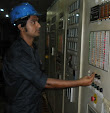Alternator-Siemens
A.C. generators or alternators (as they are usually called) operate on the same fundamental principles of electromagnetic induction as D.C. generators.
Alternating voltage may be generated by rotating a coil in the magnetic field or by rotating a magnetic field within a stationary coil. The value of the voltage generated depends on-
· The number of turns in the coil.
· Strength of the field.
· The speed at which the coil or magnetic field rotates.
Alternators generate electricity by the same principle as DC generators. When magnetic field lines cut across a conductor, a current is induced in the conductor. In general, an alternator has a stationary part (stator) and a rotating part (rotor). The stator contains windings of conductors and the rotor contains a moving magnetic field. The field cuts across the conductors, generating an electrical current, as the mechanical input causes the rotor to turn.
The rotor magnetic field may be produced by induction (in a "brushless" generator), by permanent magnets, or by a rotor winding energized with direct current through slip rings and brushes. Permanent magnet machines avoid the loss due to magnetizing current in the rotor but are restricted in size owing to the cost of the magnet material. Since the permanent magnet field is constant, the terminal voltage varies directly with the speed of the generator. Brushless AC generators are usually larger machines applications.










